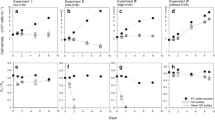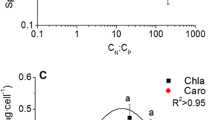Abstract
We tested the hypothesis that ultraviolet-absorbing compounds known as mycosporine-like amino acids (MAAs) are not only synthesized but also excreted by marine phytoplankton. An experiment was performed with cultures of the marine dinoflagellateLingulodinium polyedra (previously known asGonyaulax polyedra) exposed to visible (photosynthetically available, PAR, 400 to 700 nm) and ultraviolet (UV, 290 to 400 nm) radiation. Absorption properties of both particulate and dissolved organic matter pools (POM and DOM, respectively) showed maxima in ultraviolet absorption at 360 nm. Chromatographic analysis confirmed the presence of MAAs in both pools. Release of organic matter byL. polyedra, as measured spectrophotometrically by changes in UV absorption in the surrounding medium, showed a differential increase at 360 nm in cultures exposed to UV-B + PAR radiation. The changes in absorption in the DOM fraction were inversely proportional to intracellular UV absorption. Photodegradation experiments in which the DOM fraction was exposed to visible and UV-B radiation showed a decrease in absorption with dose. First-order photooxidation decay rates varied between − 0.005 and − 0.26 m2 (mol quanta)−1 and were also a function of the initial optical density (OD). These results indicate that UV-absorbing compounds synthesized by phytoplankton, such as certain dinoflagellates, may be a component of the DOM pool in surface waters of the ocean and contribute to the attenuation of UV radiation in the water column. Photooxidation consumes only 3 to 10% of the daily production of the DOM absorbing between 280 and 390 nm (including MAAs). This suggests that MAAs dissolved in seawater may contribute to the decrease of UV transmission through the water column on a time scale representative of phytoplankton growth (days) and bloom development (weeks).
Similar content being viewed by others
References
Armstrong FA, Tibbits S (1968) Photochemical combustion of organic matter in seawater for nitrogen, phosphorus, and carbon determinations. J mar biol Ass UK 48: 143–152
Bannister TT (1992) Model of the mean cosine of underwater radiance and estimation of underwater scalar irradiance. Limnol Oceanogr 37: 773–780
Benner R, Pakulski JD, McCarthy M, Hedges JI, Hatcher PG (1992) Bulk chemical characteristics of dissolved organic matter in the ocean. Science, NY 255: 1561–1564
Bricaud A, Morel A, Pricur L (1981) Absorption by dissolved organic matter of the sea (yellow substance) in the UV and visible domains. Limnol Oceanogr 26: 43–53
Bricaud A, Morel A, Prieur L (1983) Optical efficiency factors of some phytoplankters. Limnol Oceanogr 28: 816–832
Carreto JI, Carrignan MO, Daleo G, De Marco SG (1990a) Occurrence of mycosporine-like amino acids in the red tide dinoflagellateAlexandrium excavatum. UV-photoprotective compounds? J Plankton Res 12: 909–921
Carreto JI, Lutz VA, De Marco SG, Carignan MO (1990b) Fluence and wavelength dependence of mycosporine-like amino acid synthesis in the dinoflagellateAlexandrium excavatum. In: E. Granelli et al. (eds) Toxic marine photoplankton. Elsevier, New York, pp 275–279
Demmig-Adams B, Adams W.W, Heber U, Neimanis S and other co-authors (1990) Inhibition of zeaxanthin formation of rapid changes in radiationless energy dissipation by dithiotheital in spinach leaves and chloroplasts. Pl Physiol 92: 293–301
Dister B, Zafiriou OC (1993) Photochemical free radical production rates in the eastern Caribbean. J geophys Res 98: 2341–2352
Dodge JD (1989) Some revisions of the family Gonyaulacaceae (Dinophyceae) based on scanning electron microscope study. Botanica mar 32: 275–298
Döhler G (1984) Effect of UV-B radiation on the marine diatomsLauderia annulata andThalassiosira rotula grown in different salinities. Mar Biol 83: 247–253
Döhler G (1985) Effect of UV-B radiation on free amino acid pools of marine diatoms. Biochem Physiol Pfl 180: 201–211
Dunlap WC, Chalker BE, Oliver JK (1986) Bathymetric adaptations of reef-building corals at Davies Reef, Great Barrier Reef, Australia. III. UV-B absorbing compounds. J exp mar Biol Ecol 104: 239–248
Favre-Bovin J, Arpin N, Brevard C (1976) Structure de la mycosporine (P 310). Can J Chem 54: 1105–1113
Goes JI, Handa N, Taguchi S, Hama T, Saito H (1995) Impact of UV radiation on the production patterns and composition of dissolved free and combined amino acids in marine phytoplankton. J Plankton Res 17: 1337–1362
Helbling EW, Villafane V, Ferrario M, Holm-Hansen O (1992) Impact of natural ultraviolet radiation on rates of photosynthesis and on specific marine phytoplankton species. Mar Ecol Prog Ser 80: 89–100
Holm-Hansen O, Lorenzen CJ, Holmes RW, Strickland JDH (1965) Fluorometric determination of chlorophyll. J Cons perm int Explor Mer 30: 3–15
Hunter JR, Taylor JH, Moser G (1979) Effect of ultraviolet radiation on eggs and larvae of the northern anchovy,Engraulis mordax, and the Pacific mackerel,Scomber japonicus, during the embryonic stage. Photochem Photobiol 29: 325–328
Jokiel PL, RH York Jr. (1982) Solar ultraviolet photobiology of the reef coralPocillopora damicornis and symbiotic zooxanthellae. Bull mar Sci 32: 301–315
Karentz D, Cleaver JE, Mitchell DL (1991a) Cell survival characteristics and molecular responses of antarctic phytoplankton to ultraviolet-B radiation. J Phycol 27: 326–341
Karentz D, McEven FS, Land MC, Dunlap WC (1991b) Survey of mycosporine-like amino acid compounds in Antarctic marine organisms: potential protection from ultraviolet exposure. Mar Biol 108: 157–166
Kirk JTO (1981) A Monte Carlo study of the nature of the underwater light field in, and the relationships between optical properties of, turbid yellow waters. Aust J mar Freshwat Res 32: 517–532
Kirk JTO (1983) Light and photosynthesis in aquatic ecosystems. Cambridge University Press, Cambridge, England
Kouassi AM, Zika RG (1990) Light-induced alteration of the photophysical properties of dissolved organic matter in seawater. Neth J Sea Res 27: 25–32
Kouassi AM, Zika RG (1992) Light-induced destruction of the absorbance property of dissolved organic matter in seawater. Tox envirl Chem 35: 195–211
Lancelot C (1983) Metabolic changes inPhaeocystis pouchetii (Hariot) Lagerheim during the spring bloom in Belgian coastal waters. Estuar estl mar Sci 18: 593–600
Lee C, Henrichs SM (1993) How the nature of dissolved organic matter might affect the analysis of dissolved organic carbon. Mar Chem 41: 105–120
Loeblich AR III (1975) A seawater medium for dinoflagellates and the nutrition ofCachonina niei. J Phycol 11: 80–86
Lorenzen CJ (1979) Ultraviolet radiation and phytoplankton Photosynthesis. Limnol Oceanogr 24: 1117–1120
Maske H (1984) Daylight ultraviolet radiation and the photoinhibition of phytoplankton carbon uptake. J Plankton Res 6: 351–357
Miller N, Carpentier R (1991) Energy dissipation and photoprotection mechanisms during chlorophyll photobleaching in thylakoid membranes. Photochem Photobiol 54: 465–472
Mitchell BG (1990) Algorithms for determining the absorption coefficient of aquatic particulates using the quantitative filter technique (QFT). Ocean Optics (Bellingham, Wash) 10: 137–148
Mitchell BG (1992) Predictive bio-optical relationships for polar oceans and marginal ice zones. J mar Syst 3: 91–105
Mopper K, Zhou X (1990) Hydroxyl radical photoproduction in the sea and its potential impact on marine processes. Science, NY 250: 661–664
Morel A, Smith RC (1974) Relation between total quanta and total energy for aquatic photosynthesis. Limnol Oceanogr 19: 591–600.
Plane MC, Zika RG, Zepp RG, Burns LA (1987) Photochemical modeling applied to natural waters. In: Zika RG, Cooper WJ (eds) Photochemistry of environmental aquatic systems. Vol. 16. American Chemical Society, Washington, DC, pp 250–267
Ridal JJ, Moore RM (1993) Resistance to UV and persulfate oxidation of dissolved organic carbon produced by selected marine phytoplankton. Mar Chem 42: 167–188
Shibata K (1969) Pigments and a UV-absorbing substance in corals and a blue-green alga living in the Great Barrier Reef. Pl Cell Physiol, Tokyo 10: 325–335
Siebeck O (1988) Experimental investigation of UV tolerance in hematypic corals (Scleratinia). Mar Ecol Prog Ser 43: 95–103
Smith RC and 13 co-authors (1992) Ozone depletion: ultraviolet radiation and phytoplankton biology in Antarctic waters. Science, NY 255: 952–959
Stavn RH, Weidemann AD (1988) Optical modeling of clear ocean light fields: Raman scattering effects. Appl Optics 27: 4002–4011
Stavn RH, Weidemann AD (1992) Raman scattering in optics: quantitative assessment of internal radiant emission. Appl Optics 31: 1294–1303
Sundh I (1992) Biochemical composition of dissolved organic carbon released from natural communities of lake phytoplankton. Arch Hydrobiol 125: 347–369
Vernet M, Brody E, Holm-Hansen O, Mitchell BG (1994) The response of antarctic phytoplankton to ultraviolet radiation: absorption, photosynthesis and taxonomic composition. Vol. 62. In: Weiler S, Penhale P. (eds) Ultraviolet radiation and biological research in Antarctica American Geophysical Union, Washington, DC, pp 143–158
Vernet M, Neori A, Haxo FT (1989) Spectral properties and photosynthetic action in red-tide populations ofProrocentrum micans andGonyaulax polyedra. Mar Biol 103: 365–371
Whitehead K, Vernet M (1996) Exudation of mycosporine-like amino acids into the DOM pool by the red-tide dinoflagellateGonyaulax polyedra. EOS, Trans, Am geophys Un 27: p. OS72
Worrest RC, Thompson BE, Van Dyke H (1981) Impact of UV-B radiation upon estuarine microcosms. Photochem Photobiol 33: 861–867
Yentsch CS, Yentsch CM (1982) The attenuation of light by marine phytoplankton with specific reference to the absorption of near-UV radiation. In: Calkins J (ed) Role of solar ultraviolet radiation in marine ecosystems. Plenum Press, New York, pp 691–700
Zar JH (1984) Biostatistical analysis. Prentice-Hall Inc., Englewood Cliffs, New Jersey
Zlotnik I, Dubinsky Z (1989) The effect of light and temperature on DOC excretion by phytoplankton. Limnol Oceanogr 34: 831–839
Author information
Authors and Affiliations
Additional information
Communicated by M. F. Strathmann, Friday Harbor
Rights and permissions
About this article
Cite this article
Vernet, M., Whitehead, K. Release of ultraviolet-absorbing compounds by the red-tide dinoflagellateLingulodinium polyedra . Mar. Biol. 127, 35–44 (1996). https://doi.org/10.1007/BF00993641
Received:
Accepted:
Issue Date:
DOI: https://doi.org/10.1007/BF00993641




